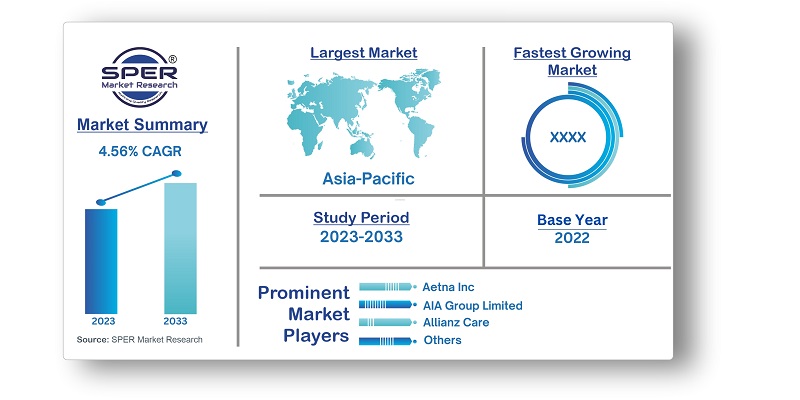
Asia Pacific Health Insurance Market Growth, Size, Share, Revenue, Trends and Future Outlook 2033
Asia Pacific Health Insurance Market Size- By Type, By Services, By Level of Coverage, By Service Providers, By Health Insurance Plans, By Demographics, By Coverage Type, By Distribution Channel, By End User- Regional Outlook, Competitive Strategies and Segment Forecast to 2033
| Published: Feb-2023 | Report ID: BFSI2308 | Pages: 1 - 153 | Formats*: |
| Category : BFSI | |||
- In 2020: Aetna Inc. has recently unveiled a revised policy addressing infectious diseases, with a particular focus on COVID-19, aimed at bolstering the well-being of its members. This strategic move not only strengthens the company's commitment to its existing customers but also enhances its overall product offering, potentially attracting a broader clientele.

- Increasing Number of Elderly in the Population: The market is experiencing growth due to the rising proportion of elderly individuals. Japan, being one of the most aged nations, is witnessing a swift aging process. Many older people are increasingly relying on insurance services and are choosing to invest in health insurance plans to feel more secure. Consequently, this trend is driving market expansion.
- Significant Spending on Medical Procedures and Treatment: Increasing medical expenses, including surgeries, hospital stays, and diagnostics, have led to a demand for health insurance, offering financial protection against severe illnesses or accidents. Skyrocketing healthcare costs, a major cause of bankruptcy, especially among uninsured or underinsured families, burdens patients. Health insurance, offering financial assistance, contributes to market growth by alleviating this financial strain.
- High Cost of Insurance Premiums: Health insurance encompasses various medical treatment expenses, including pre and post-hospitalization costs. To maintain an active health insurance policy, policyholders must consistently pay insurance premiums. The premium cost often varies depending on the insurance plan, potentially acting as a hindrance to the market's expansion.

| Report Metric | Details |
| Market size available for years | 2019-2033 |
| Base year considered | 2022 |
| Forecast period | 2023-2033 |
| Segments covered | By Type, By Services, By Level of Coverage, By Service Providers, By Health Insurance Plans, By Demographics, By Coverage Type, By Distribution Channel, By End User |
| Regions covered | Australia, China, India, Indonesia, Japan, Malaysia, New Zealand, Philippines, Singapore, South Korea, Taiwan, Thailand, Vietnam, Rest of APAC |
| Companies Covered | Aetna Inc., AIA Group Limited, Allianz Care, ASSICURAZIONI GENERALI S.P.A, Aviva, AXA, Bupa, Cigna, HBF Health Limited, HealthCare International Global Network Ltd., International Medical Group, Inc., MAPFRE, Now Health International, Oracle, Others |
- Individuals and Families
- Employers and Small Businesses
- Seniors and Retirees
- Low-Income Individuals and Families
- Others
| By Type: |
|
| By Services: |
|
| By Level of Coverage: |
|
| By Service Providers: |
|
| By Health Insurance Plans: |
|
- Asia Pacific Health Insurance Market Size (FY’2023-FY’2033)
- Overview of Asia Pacific Health Insurance Market
- Segmentation of Asia Pacific Health Insurance Market By Type (Product, Solutions)
- Segmentation of Asia Pacific Health Insurance Market By Services (Inpatient Treatment, Medical Assistance, Outpatient Treatment, Others)
- Segmentation of Asia Pacific Health Insurance Market By Level of Coverage (Bronze, Gold, Platinum, Silver)
- Segmentation of Asia Pacific Health Insurance Market By Service Providers (Private Health Insurance Providers, Public Health Insurance Providers)
- Segmentation of Asia Pacific Health Insurance Market By Health Insurance Plans (Exclusive Provider Organization, Health Maintenance Organization, Health Savings Account, Indemnity Health Insurance, Point of Service, Preferred Provider Organization, Qualified Small Employer Health Reimbursement Arrangement, Others)
- Segmentation of Asia Pacific Health Insurance Market By Demographics (Adults, Minors, Senior Citizens)
- Segmentation of Asia Pacific Health Insurance Market By Coverage Type (Lifetime Coverage, Term Coverage)
- Segmentation of Asia Pacific Health Insurance Market By Distribution Channel (Clinics, Direct Sales, E-Commerce, Financial Institutions, Hospitals, Others)
- Segmentation of Asia Pacific Health Insurance Market By End User (Corporate, Individuals, Others)
- Statistical Snap of Asia Pacific Health Insurance Market
- Expansion Analysis of Asia Pacific Health Insurance Market
- Problems and Obstacles in Asia Pacific Health Insurance Market
- Competitive Landscape in the Asia Pacific Health Insurance Market
- Impact of COVID-19 and Demonetization on Asia Pacific Health Insurance Market
- Details on Current Investment in Asia Pacific Health Insurance Market
- Competitive Analysis of Asia Pacific Health Insurance Market
- Prominent Players in the Asia Pacific Health Insurance Market
- SWOT Analysis of Asia Pacific Health Insurance Market
- Asia Pacific Health Insurance Market Future Outlook and Projections (FY’2023-FY’2033)
- Recommendations from Analyst
1.1. Scope of the report1.2. Market segment analysis
2.1. Research data source2.1.1. Secondary Data2.1.2. Primary Data2.1.3. SPER’s internal database2.1.4. Premium insight from KOL’s2.2. Market size estimation2.2.1. Top-down and Bottom-up approach2.3. Data triangulation
4.1. Driver, Restraint, Opportunity and Challenges analysis4.1.1. Drivers4.1.2. Restraints4.1.3. Opportunities4.1.4. Challenges4.2. COVID-19 Impacts of the Asia Pacific Health Insurance Market
5.1. SWOT Analysis5.1.1. Strengths5.1.2. Weaknesses5.1.3. Opportunities5.1.4. Threats5.2. PESTEL Analysis5.2.1. Political Landscape5.2.2. Economic Landscape5.2.3. Social Landscape5.2.4. Technological Landscape5.2.5. Environmental Landscape5.2.6. Legal Landscape5.3. PORTER’s Five Forces5.3.1. Bargaining power of suppliers5.3.2. Bargaining power of buyers5.3.3. Threat of Substitute5.3.4. Threat of new entrant5.3.5. Competitive rivalry5.4. Heat Map Analysis
6.1. Asia Pacific Health Insurance Market Manufacturing Base Distribution, Sales Area, Product Type6.2. Mergers & Acquisitions, Partnerships, Product Launch, and Collaboration in Asia Pacific Health Insurance Market
7.1. Asia Pacific Health Insurance Market Value Share and Forecast, By Type, 2023-20337.2. Product7.3. Solutions
8.1. Asia Pacific Health Insurance Market Value Share and Forecast, By Services, 2023-20338.2. Inpatient Treatment8.3. Medical Assistance8.4. Outpatient Treatment8.5. Others
9.1. Asia Pacific Health Insurance Market Value Share and Forecast, By Level of Coverage, 2023-20339.2. Bronze9.3. Gold9.4. Platinum9.5. Silver
10.1. Asia Pacific Health Insurance Market Value Share and Forecast, By Service Providers, 2023-203310.2. Private Health Insurance Providers10.3. Public Health Insurance Providers
11.1. Asia Pacific Health Insurance Market Value Share and Forecast, By Health Insurance Plans, 2023-203311.2. Exclusive Provider Organization11.3. Health Maintenance Organization11.4. Health Savings Account11.5. Indemnity Health Insurance11.6. Point of Service11.7. Preferred Provider Organization11.8. Qualified Small Employer Health Reimbursement Arrangement11.9. Others
12.1. Asia Pacific Health Insurance Market Value Share and Forecast, By Demographics, 2023-203312.2. Adults12.3. Minors12.4. Senior Citizens
13.1. Asia Pacific Health Insurance Market Value Share and Forecast, By Coverage Type, 2023-203313.2. Lifetime Coverage13.3. Term Coverage
14.1. Asia Pacific Health Insurance Market Value Share and Forecast, By Distribution Channel, 2023-203314.2. Clinics14.3. Direct Sales14.4. E-Commerce14.5. Financial Institutions14.6. Hospitals14.7. Others
15.1. Asia Pacific Health Insurance Market Value Share and Forecast, By Level of Coverage, 2023-203315.2. Corporate15.3. Individuals15.4. Others
16.1. Asia Pacific Health Insurance Market Size and Market Share
17.1. Asia Pacific Health Insurance Market Size and Market Share By Type (2019-2026)17.2. Asia Pacific Health Insurance Market Size and Market Share By Type (2027-2033)
18.1. Asia Pacific Health Insurance Market Size and Market Share By Services (2019-2026)18.2. Asia Pacific Health Insurance Market Size and Market Share By Services (2027-2033)
19.1. Asia Pacific Health Insurance Market Size and Market Share By Level of Coverage (2019-2026)19.2. Asia Pacific Health Insurance Market Size and Market Share By Level of Coverage (2027-2033)
20.1. Asia Pacific Health Insurance Market Size and Market Share By Service Providers (2019-2026)20.2. Asia Pacific Health Insurance Market Size and Market Share By Service Providers (2027-2033)
21.1. Asia Pacific Health Insurance Market Size and Market Share By Health Insurance Plans (2019-2026)21.2. Asia Pacific Health Insurance Market Size and Market Share By Health Insurance Plans (2027-2033)
22.1. Asia Pacific Health Insurance Market Size and Market Share By Demographics (2019-2026)22.2. Asia Pacific Health Insurance Market Size and Market Share By Demographics (2027-2033)
23.1. Asia Pacific Health Insurance Market Size and Market Share By Coverage Type (2019-2026)23.2. Asia Pacific Health Insurance Market Size and Market Share By Coverage Type (2027-2033)
24.1. Asia Pacific Health Insurance Market Size and Market Share By Distribution Channel (2019-2026)24.2. Asia Pacific Health Insurance Market Size and Market Share By Distribution Channel (2027-2033)
25.1. Asia Pacific Health Insurance Market Size and Market Share By End User (2019-2026)25.2. Asia Pacific Health Insurance Market Size and Market Share By End User (2027-2033)
26.1. Asia Pacific Health Insurance Market Size and Market Share by Region (2019-2026)26.2. Asia Pacific Health Insurance Market Size and Market Share by Region (2027-2033)26.3. Australia26.4. China26.5. India26.6. Indonesia26.7. Japan26.8. Malaysia26.9. New Zealand26.10. Philippines26.11. Singapore26.12. South Korea26.13. Taiwan26.14. Thailand26.15. Vietnam26.16. Rest of APAC
27.1. Aetna Inc.27.1.1. Company details27.1.2. Financial outlook27.1.3. Product summary27.1.4. Recent developments27.2. AIA Group Limited27.2.1. Company details27.2.2. Financial outlook27.2.3. Product summary27.2.4. Recent developments27.3. Allianz Care27.3.1. Company details27.3.2. Financial outlook27.3.3. Product summary27.3.4. Recent developments27.4. ASSICURAZIONI GENERALI S.P.A27.4.1. Company details27.4.2. Financial outlook27.4.3. Product summary27.4.4. Recent developments27.5. Aviva27.5.1. Company details27.5.2. Financial outlook27.5.3. Product summary27.5.4. Recent developments27.6. AXA27.6.1. Company details27.6.2. Financial outlook27.6.3. Product summary27.6.4. Recent developments27.7. Bupa27.7.1. Company details27.7.2. Financial outlook27.7.3. Product summary27.7.4. Recent developments27.8. Cigna27.8.1. Company details27.8.2. Financial outlook27.8.3. Product summary27.8.4. Recent developments27.9. HBF Health Limited27.9.1. Company details27.9.2. Financial outlook27.9.3. Product summary27.9.4. Recent developments27.10. HealthCare International Global Network Ltd.27.10.1. Company details27.10.2. Financial outlook27.10.3. Product summary27.10.4. Recent developments27.11. International Medical Group, Inc.27.11.1. Company details27.11.2. Financial outlook27.11.3. Product summary27.11.4. Recent developments27.12. MAPFRE27.12.1. Company details27.12.2. Financial outlook27.12.3. Product summary27.12.4. Recent developments27.13. Now Health International27.13.1. Company details27.13.2. Financial outlook27.13.3. Product summary27.13.4. Recent developments27.14. Oracle27.14.1. Company details27.14.2. Financial outlook27.14.3. Product summary27.14.4. Recent developments27.15. Others
SPER Market Research’s methodology uses great emphasis on primary research to ensure that the market intelligence insights are up to date, reliable and accurate. Primary interviews are done with players involved in each phase of a supply chain to analyze the market forecasting. The secondary research method is used to help you fully understand how the future markets and the spending patterns look likes.
The report is based on in-depth qualitative and quantitative analysis of the Product Market. The quantitative analysis involves the application of various projection and sampling techniques. The qualitative analysis involves primary interviews, surveys, and vendor briefings. The data gathered as a result of these processes are validated through experts opinion. Our research methodology entails an ideal mixture of primary and secondary initiatives.



Frequently Asked Questions About This Report
PLACE AN ORDER
Year End Discount
Sample Report
Pre-Purchase Inquiry
NEED CUSTOMIZATION?
Request CustomizationCALL OR EMAIL US
100% Secure Payment






Related Reports
Our Global Clients
Our data-driven insights have influenced the strategy of 200+ reputed companies across the globe.






















